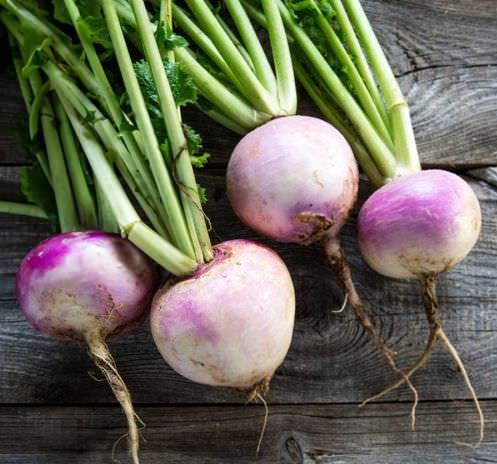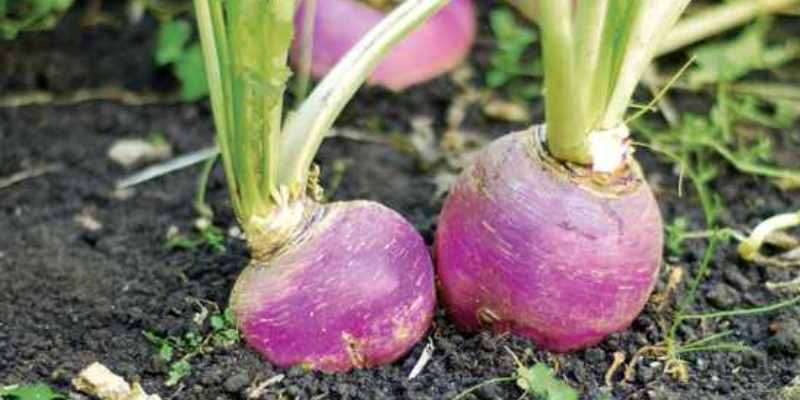Turnips are vegetables with a colour of creamy white and a purple top. People often group this popular staple food with root vegetables, such as beetroot and potato. However, the turnip is actually a member of broccoli, arugula, Brussels sprouts, and the kale family.
Farmers grow the turnip (Brassica rapa) in temperate, subtropical and tropical areas of India. They cultivate it in Haryana, Punjab, Bihar, Himachal Pradesh, and Tamil Nadu. A cool and moist climate is most favourable for growing turnips. However, they can also grow where summers are mild.
Note – When you start farming, choose the equipment made according to the relevant agriculture, which is most important. However, farmers mostly use the Swaraj Tractor in every farming. Therefore, you should be aware and careful regarding every requirement in the business.
Turnip Farming – Climate Information
Turnip vegetables grow well in moist and cool climatic conditions. Farmers require short day lengths and long night lengths. This vegetable is a winter season crop for the good development of the roots. During the critical stage of the growth period, these trees require good sunlight. The turnip trees remain evergreen in tropical climates. The optimum growth of the turnip plant requires around 6-8 hours of direct exposure to sunlight.
Temperature Requirement
For optimum growth rate, the turnip crop requires a little less temperature from the average temperature range of India. The Ideal range is between 10°C to 16°C for turnip crops. However, the Asian variety of the plant can still survive at temperatures higher than this. Temperatures below 5 °C and temperatures above 25 °C can negatively affect the crop and reduce yield.
Requirement of Rainfall
Turnip trees require a humid climate with an evenly distributed annual rainfall of about 500 mm to 600 mm. However, turnip trees can easily survive in less rain than this. However, trees are sensitive to water stagnation, and thus waterlogging from excessive rainfall in the absence of proper drainage can damage the roots of plants. Therefore, the construction of a good drainage system in areas with high rainfall should be the priority of the farmers.

Turnip Farming – Suitable soil
Farmers can cultivate turnip trees in northern India’s sandy loam or alluvial soils to deep clay loam or lateritic/acidic or black soils in the Deccan plateau and north-eastern hills. But, the most suitable soil conditions are well-drained and highly fertile sandy loam to medium-heavy soils.
It has a high organic matter content and a high percentage of humus. Soil with poor drainage is not suitable. The optimum range of pH is from 6.5 to 7.5. PH values 10 and above and below 4 will result in very poor yields and require appropriate soil treatment. You should avoid the very light sandy soil or very heavy soil at all costs for the commercial cultivation of turnips.
Turnip Farming – Land Preparation
Like all other commercial farming, an important task for turnip cultivation is proper land preparation. It will also level and clear the vegetation of already grown crops. After these ploughings, the remaining soil clumps should be crushed by hand with a country plough or other machines as it is conducive to germination. After opening the topsoil, the land is dry in the sun for 15 days. It will ensure the eradication of weeds and potential weed seeds. After that, about 25 tonnes of well-rotted field manure (FYM) should be spread evenly over the soil. Then, farmers should mix well with the soil after further ploughing. After that, irrigation ridges, grooves and channels are made for further work.
Turnip Farming – Sowing methods and tips
The reproduction of turnip plants is by seeds only. No vegetative methods of propagation are practised. However, farmers sow the seeds by the line sowing method directly in the lines prepared during the preparation of bund or land. They sow the seeds deep into the soil (at least 1.5 cm) for proper nutrient availability and better chances of germination. However, it should be done in low-lying areas affected by waterlogging, especially on the meadows.
Turnip Farming – Irrigation Methods
Farmers do the light irrigation to the plants immediately after sowing and later do the irrigation after 8-10 days of irrigation. Turnip plants require a moist climate. Therefore, the irrigation frequency can change depending on the climate, water-holding capacity, and other soil characteristics. Farmers can irrigate at an interval of 15-25 days in the later stage. In case of winter rains, farmers should stop the irrigation from maintaining proper moisture conditions in the soil. But, during heavy rains and floods, you should remove the stagnant water quickly in the soil.
Weed Control or Intercultural Operations
For turnip plants, 3 weddings at an interval of one or two months are necessary to control unwanted weeds as they affect the overall yield of the plants. After each crop, you should weed to prepare the field for the next batch. Farmers can also use Chemical weedicides like Tok E-25 at the rate of 2 kg per hectare or Terbutryn @ 1 kg per hectare in these limits for better outcomes. Mulching through a 100-micron recyclable black polythene sheet is also a good option to control weeds. You should use 12 to 15 cm thick mulch for organic mulching, so that water can reach the roots of the plants.
Need the Equipment for Turnip Farming
When farmers want to grow something, they need equipment to get a better yield because today, equipment plays a major role in farming. However, farming requires various tools, such as rotavator, cultivator, tractor and many other types of equipment. The tractor is important among equipment, and farmers usually use the New Holland Tractor in turnip cultivation.
For more information regarding turnip farming in India, stay tuned with us.

